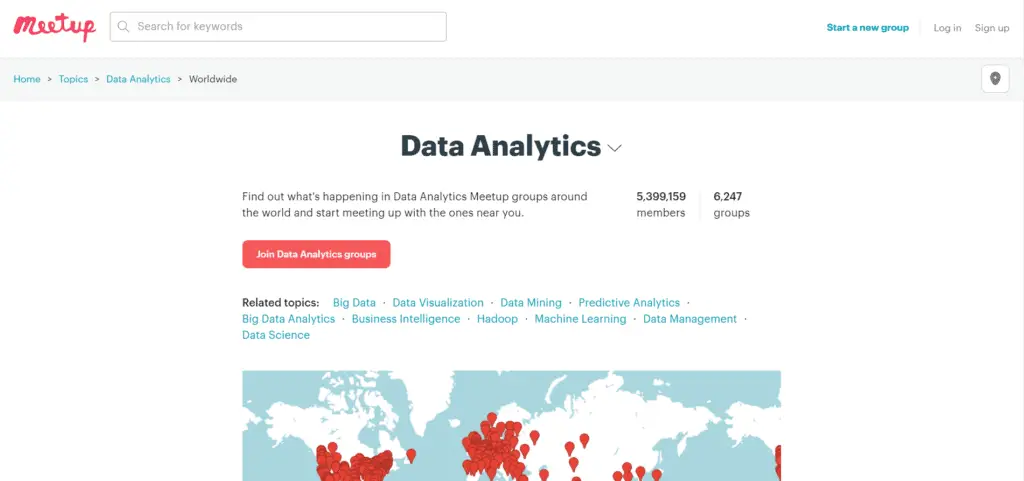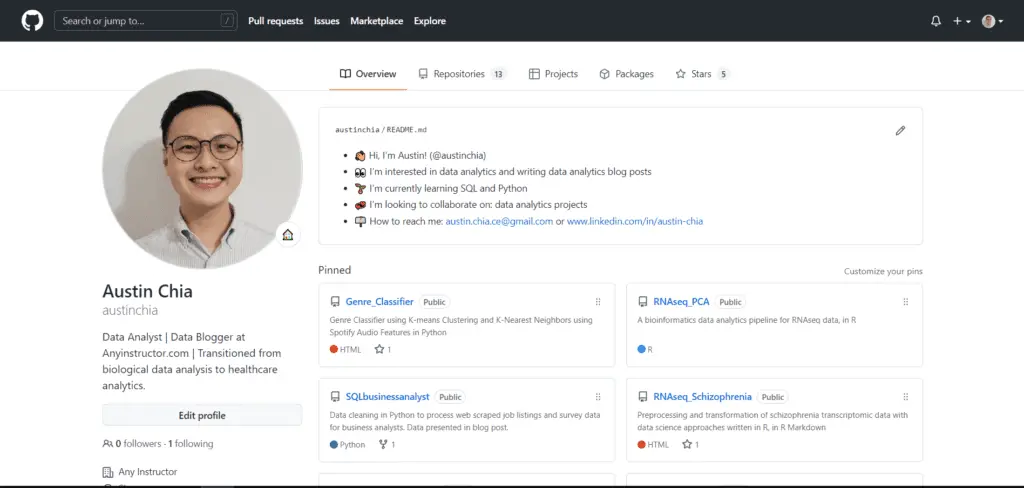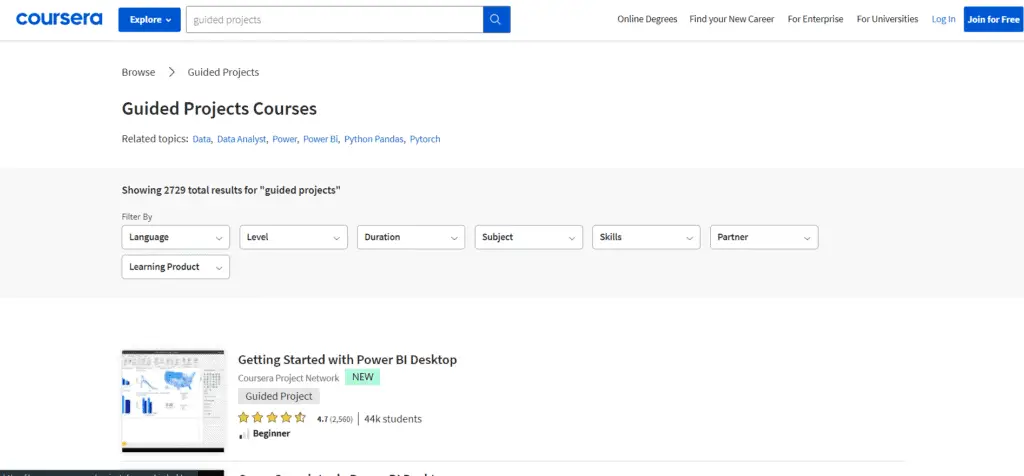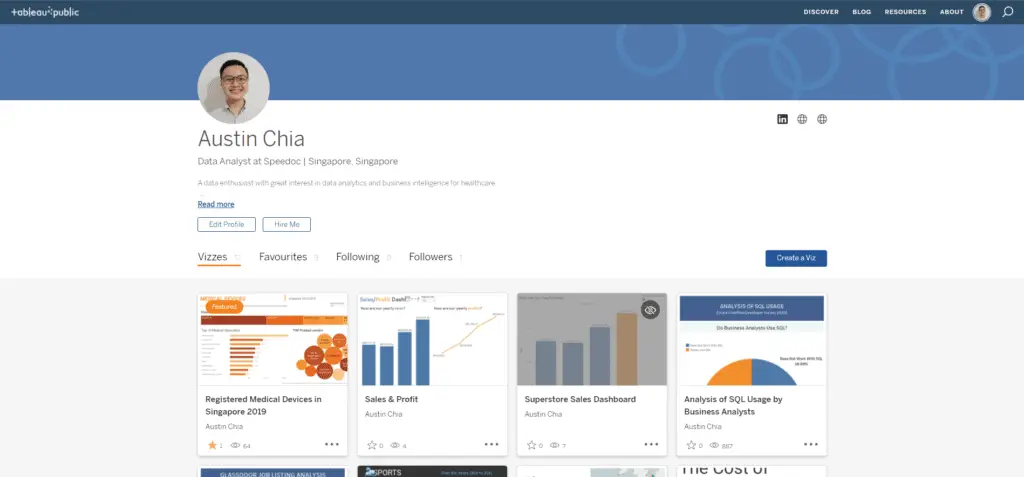This post may contain paid links to my personal recommendations that help to support the site!
Chances are, you’re currently learning data analytics, and this problem has come up: What are some of the smarter ways to learn data analytics?
I’ve done my research on this and here are the 9 ways:
9 Smarter Ways to Get Started Learning Data Analytics

- Join a Data Analytics Community
- Attend Analytics Meetups
- Find a Mentor
- Work on Personal Projects
- Publish and Get Feedback on Your Portfolio
- Read Data Blogs
- Watch Data Analytics YouTube Videos
- Read Good Resource Books
- Stick to Learning From a Well-Structured Online Course
Learning data analytics without the right resources can be a REAL pain and hinder your learning progress!
With these 9 smarter ways to learn, I’m sure you’ll find yourself learning at a much more effective pace.
Read on as I share my reasons for choosing them (+links)!
1. Join a Data Analytics Community

A great way to learn is to connect with other data analytics enthusiasts!
Here’s a summary table of my recommended community sites:
| Community | Description | |
| 1 | LinkedIn Community | A career-focused social media site with great community features such as Linkedin Groups. |
| 2 | Reddit Community | An internet forum with subreddits across many topics, including data analytics and data science. Recommended subreddit pages here. |
| 3 | Quora Community | An internet question and answer forum, across topics in data analytics and data science. |
| 4 | Discord Community Servers | Discord is a community-focused chat application with many features for community building. Read about the top data science discord servers here. |
| 5 | Kaggle Discussion Forums | Kaggle has discussion forums on topics across data analytics, ranging from highly-technical questions to beginner advice. |
Read my blog on the best data science subreddits here.
OR
Read about the best data science discord servers here!
Here’s what I really love about communities – the sharing of resources and experiences!
For example, a fellow learner may share the same pain of learning a new skill as you!
This might lead to the sharing of cheatsheets and commonly encountered bugs while learning data analytics!
2. Attend Analytics Meetups

Another good way to connect is to speak to other learners or industry seniors directly!
Let’s have a look at the 2 types of meetups
- Virtual Meetups
- Physical Meetups
With more people used to virtual meetups after the pandemic started in 2020, virtual meetups are completely viable!

Virtual meetups allow you to get to know others who have been down the same path as you do!
This means that you’ll gain more insight into any common mistakes when learning or even better – connect you to new opportunties!
Alternatively, you can connect to others in your area via physical meetups.
This means that you’ll be able to share resources with other learners in a more organic way.
Whichever you prefer, you can try looking for other like-minded data individuals on Meetup.

Meetup is an online portal that connects you to groups of communities with the intention to bring people together!
Who knows, you might even gain lots of tips and tricks to improve your data analytics learning as well!
You’ll be able to meet data analysts, business intelligence analysts, and data scientists in your area too!
Curious to know the difference between data analysts and bi analysts?
Read more in my article here!
3. Find a Mentor

Now, all this networking should lead you to someone whom you can really get along with.
If they are willing you should consider having them as an industry mentor!
A data analytics mentor has already been through the same learning journey and mistakes. There’s much to learn from them!
Other than looking for a mentor from a meetup on Meetup, you can even do a cold connect on LinkedIn!
Here’s a neat article I use to cold connect with others on LinkedIn!
4. Work on Personal Projects

Personal projects are important to help you practice your skills on something you’re interested in.
Additionally, employers will be impressed with a well-balanced and well-presented project portfolio!
Here are some sites that can give you ideas on projects:
- Kaggle
- Github
- Guided Projects
- Walkthroughs on Medium
Kaggle

Kaggle is one of my favorite sites to visit when I’m looking for inspiration for my next data analytics project!
Kaggle is well-known for its competitions. If you’re keen to learn data analytics the more organic way, go ahead and sign up for some of these competitions!
Now, not to worry, these will just be a platform for you to use the analytics skills you’ve learned and not solely for competing for a prize!
Also, Kaggle is known for its collection of freely-available datasets!
This means that you can pick any of the available datasets to download.
This should help you get started with data transformation!
Github
Github is a version control portal that is commonly used in the data analytics and data science space!
It’s well-known for the freely-available code uploaded by other coders and analysts out there.
I’d personally recommend getting an account and exploring the code and projects uploaded by other analysts!
Here’s my profile as reference:

Link here: https://github.com/austinchia
I personally use Github to check out what other data analysts do for their personal data projects. This usually gives me inspiration for a project idea!
Do check out Github here!
Guided Projects

If you’re hesitant about getting started on a project on your own, you can also take the path of guided projects!
Put simply, guided projects are step-by-step walkthroughs of data projects.
More specifically, Coursera, a popular online learning platform offers such short guided projects.
These projects are comprehensive but simple enough for beginners to get started for the first time.
Here are some projects you may be interested in:
| Guided Project Title | Software | Link | |
| 1 | Create Interactive Dashboards with Streamlit and Python | Python | Link |
| 2 | Predictive Analytics for Business with H2O in R | R Programming | Link |
| 3 | Getting Started with Power BI Desktop | Power BI | Link |
| 4 | Creating an Interactive KPI Management Dashboard in Tableau | Tableau | Link |
They provide the convenience of having all necessary information included in a single course.
On Coursera, these projects are led by an experienced instructor through video lectures.
And that’s perfect! You’ll be able to pause a video to follow the steps and resume when you’re ready for the next!
However, such guided projects come with a small, one-time cost on Coursera.
But I’d say they’re worth it if you prefer some guidance in your learning!
Walkthroughs on Medium

Alternatively, if you’re on a budget and spending is not an option, you can always go for free content on Medium!
Medium is full of free blogs that have walkthroughs of projects done by real data scientists and analysts. This is valuable to new learners in data analytics as you’ll be able to understand how things are done.
Interested to get started?
Try looking at the data analysis tag on Medium over here.
Curious to learn more about how long data science projects take?
Check out my article on data science projects here!
5. Publish and Get Feedback on Your Portfolio
Alright, so if you’ve already done some projects of your own and you’re looking to learn more, you should get some feedback!
The best way I’d recommend is to look to others for their opinion on your projects.
Here are a few ways to get feedback:
- Publish on LinkedIn
- Publish on Github
- Publish dashboards online
- Write a blog post
Publishing on LinkedIn is a great way that most of us can start! If you’ve created a project for yourself, go ahead and create a post!
Your connections and network might be able to provide a good critique of your analysis. You can also consider joining LinkedIn groups to share!
I’m personally in this “Data Science Community” group here and a Community From the Google Data Analytics Certificate Course here.
Publishing on Github can also be useful when sharing your content on LinkedIn! This helps readers look at your code directly.
Publishing your data visualizations and dashboards online is great too! I’d recommend publishing to Tableau Public if you’ve created some Tableau Dashboards.

You can check out my Tableau Public profile here.
Publishing a blog post about your project is a good choice too! This makes your project shareable, so that others may learn from your project.
By sharing online, you allow others to provide very critical feedback on your projects and how you approach them!
That’s one of the reasons why I’m here writing this blog post!
You can start by either creating your own website on Medium, WordPress.com, or a paid website on WordPress.org.
An example of that is this blog, Any Instructor!
6. Read Data Blogs
The first way is pretty obvious to most people at a first glance – learning from data blogs.
HOWEVER, you have to be picky about the blogs you choose to follow/read. Selecting the wrong ones will just lead to demotivation when learning!
Here are some criteria to consider when selecting blogs to learn:
- Comprehensiveness
- Type of content
- Readability
The comprehensiveness of blogs is the single most important reason why you’ll consider learning from blogs.
You’re gonna want to read blogs that cover in-depth content and learn something new after reading.
For some great resources, check out TowardsDataScience for some user-submitted posts by analytics professionals. They typically cover basic to advanced concepts!
You can also check out our site, AnyInstructor.com, for really in-depth reviews and learning guides! You can start here.
The type of content needs to be considered for data blogs as well. The two main types are instructional and informational.
Instructional blog posts guide you through a process or project.
Informational posts, provide you with more background “book” knowledge and link you to useful resources.
I personally read KDNuggets, the Tableau Blog, and Exceljet for some really good instructional and informational posts! You’re sure to learn something from them too.
Curious to know my full list of 11 recommended data analytics blogs? Check out my article here.
The readability is a crucial factor as well! Ideally, you’d like a blog that keeps you reading and learning.
Find a blog that’s easy to read, written in a casual manner to keep you engaged in learning.
For high readability content, I’d stay away from blogs from corporate websites.
Try to go for more personal bloggers or blogs with user-submitted content!
I personally recommend this blog, Anyinstructor.com, because I write with high readability in mind, for both beginners and advanced analysts!
Alternatively, you can head to TowardsDataScience for personal posts.
7. Watch Data Analytics YouTube Videos

Another free method to learn data analytics is through video content.
For this, I recommend using YouTube, which you’re probably already very familiar with!
When selecting YouTube videos to watch, make sure to watch videos that either instruct or educate. Watching just some for entertainment is fine, but you’re here to learn!
For YouTube channels, I’d recommend the Alex the Analyst channel, where both such videos are covered!
Check out a video from his channel below!
If you’re still looking for more, do consider supporting our own Any Instructor Data Analytics YouTube channel! I’d greatly appreciate it!
Here’s a video preview:
Need more recommendations for data analytics YouTube channels, go check out my other blog post on them here.
Or if you’re more interested in business intelligence, check out this other article on our top 10 picks for BI YouTube channels.
Prefer to just listen instead of watch videos?
You might like this other article on the top 8 data analytics podcasts!
8. Read Good Resource Books
If you’re a regular reader of my blog posts, you’ll know how much I love to have handy resource books with me to help me in my learning.
To help you learn better, get ONE good resource book for each skill you’re learning and stick to them as a resource guide.
For each book, commit to the exercises in them and also make sure to use it as a reference and guiding post through different checkpoints in your data analytics learning journey.
Having a physical book is REALLY crucial and you shouldn’t underestimate the use of physically referring to a book while coding.
Why? So you won’t have to switch back between an electronic version on different windows on your computer!
Here are some recommended books based on topics:
| Topics | Title | Link | |
| 1 | Tableau | Practical Tableau | Amazon |
| 2 | Power BI | Beginning Microsoft Power BI | Amazon |
| 3 | Python Programming | Python for Data Analysis | Amazon |
| 4 | SQL | SQL: The Ultimate Beginners Guide: Learn SQL Today | Amazon |
| 5 | Data Visualization | Big Book of Dashboards | Amazon |
9. Stick to Learning From a Well-Structured Online Course
If you’ve been learning a lot from YouTube, you’ll realize that you’ve begun to exhaust all of the good free data analytics learning resources.
Here’s how I broke out of that plateau in my data analytics learning – well-structured online courses.
Learning data analytics alone can be tough, but going through lectures on an online course can make that learning process so much more enjoyable!
Go for well-structured online courses, because it gets hard to complete an online course when things are messy!
Here are some reasons why I choose to have PAID and WELL-STRUCTURED online courses:
- Paying for courses provides me extra motivation
- Structure gives me consistent learning to reach my learning goals
Online courses give you a structured way of learning as well as a consistent learning platform to ensure all fundamentals are covered!
Here’s why these structured courses do well: they mimic the success of formal education!
With weekly reminders to stay on track on platforms like Coursera, you’re more likely to keep pushing on.
Here’s a table of my favorite learning platforms, do check them out:
| Learning Platform | What’s Good About the Platform | Link | |
| 1 | Coursera | Certificates are offered by popular learning institutes and companies | Link |
| 2 | Datacamp | Integrated coding platform for friendlier learning | Link |
| 3 | Pluralsight | Strong focus on learning tech skills, taught by industry experts | Link |
QUICK TIP: Go for online course subscriptions!
Most online course subscriptions such as the Google Data Analytics Professional Certificate run on a monthly payment basis.
This means that the faster you complete a course, the less you pay for the same amount of learning material!
Want to know more about the Google Data Analytics Professional Certificate? Check out my full review here.
Curious to know what I’d recommend getting for data analytics certificates and online courses? Check out this article I wrote over here.
Related Questions
Can I Teach Myself Data Analytics?
Data analytics can be self-taught. Data analytics typically requires technical skills that can be learned through teaching oneself. Resources for these analytics skills are very much available online. However, teaching oneself data analytics can be tough without proper direction and guidance.
Learning by yourself is possible, but it will be tough! Make sure to take advantage of all the resources you can get.
Read more about data analytics certificates over here.
What Should I Learn for Data Analytics?
SQL, Python, Excel, and Tableau should be learned for data analytics. These technical skills represent data querying, analysis, transformation, and visualization respectively. These skills are key to the data analytics field. However, although these skills remain the same, these tools may vary based on project needs.
Curious about Tableau? You may want to check out my blog post on learning Tableau over here.
Is Coding Required for Data Analytics?
Coding is required for data analytics. Data analytics requires the use of coding languages to explore, clean, analyze and present data. Coding languages like Python and R are also used in data analysis and SQL for querying. However, the requirement for coding in data analytics varies across job functions and industries.
Read about the requirements for coding in data science here.
Final Thoughts
Alright, that’s all the 9 smarter ways to learn data analytics. I do hope you’ve learned something from this post too!
Go ahead and use the links I’ve added below to get started learning! Thank you.
My Favorite Learning Resources:
My Recommended Learning Platforms!
| Learning Platform | What’s Good About the Platform? | |
|---|---|---|
| 1 | Coursera | Certificates are offered by popular learning institutes and companies like Google & IBM |
| 2 | DataCamp | Comes with an integrated coding platform, great for beginners! |
| 3 | Pluralsight | Strong focus on data skills, taught by industry experts |
| 4 | Stratascratch | Learn faster by doing real interview coding practices for data science |
| 5 | Udacity | High-quality, comprehensive courses |
My Recommended Online Courses + Books!
| Topic | Online Courses | Books | |
|---|---|---|---|
| 1 | Data Analytics | Google Data Analytics Professional Certificate | – |
| 2 | Data Science | IBM Data Science Professional Certificate | – |
| 3 | Excel | Excel Skills for Business Specialization | – |
| 4 | Python | Python for Everybody Specialization | Python for Data Analysis |
| 5 | SQL | Introduction to SQL | SQL: The Ultimate Beginners Guide: Learn SQL Today |
| 6 | Tableau | Data Visualization with Tableau | Practical Tableau |
| 7 | Power BI | Getting Started with Power BI Desktop | Beginning Microsoft Power BI |
| 8 | R Programming | Data Science: Foundations using R Specialization | Learning R |
| 9 | Data Visualization | – | Big Book of Dashboards |

